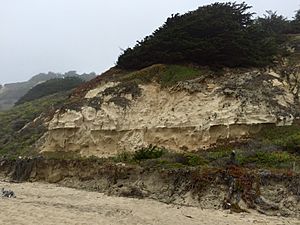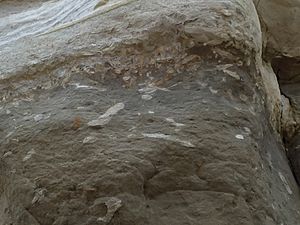Purisima Formation facts for kids
Quick facts for kids Purisima FormationStratigraphic range: Late Miocene-Early Pleistocene ~11.5–2.5Ma |
|
|---|---|

Outcrop of Purisima Formation sandstone at San Gregorio State Beach
|
|
| Type | Formation |
| Lithology | |
| Primary | Sandstone, siltstone |
| Other | Conglomerate, phosphorite |
| Location | |
| Region | California |
| Country | United States |
The Purisima Formation is a special layer of rock found in California. It's like a giant history book made of stone! This formation holds amazing clues about life from a very long time ago. Scientists study it to learn about animals and plants that lived between about 11.5 million and 2.5 million years ago. This time is known as the Late Miocene to Early Pleistocene epochs.
Contents
Discovering the Purisima Formation
What is a Rock Formation?
A rock formation is a group of rock layers that look similar. These layers are often found in a specific area. They can tell us about the Earth's past. Geologists are scientists who study rocks. They give names to these formations. The Purisima Formation is named after a place in California.
Where is the Purisima Formation Found?
The Purisima Formation is located in California, a state in the United States. You can see parts of it along the coast. It stretches through areas like Santa Cruz and San Mateo counties. These rock layers are a big part of the landscape there.
What is the Purisima Formation Made Of?
The Purisima Formation is mostly made of two types of rock. These are sandstone and siltstone.
- Sandstone is rock made from tiny grains of sand. It often forms in ancient beaches or riverbeds.
- Siltstone is similar but made from even finer particles called silt.
Sometimes, you might also find conglomerate in the Purisima Formation. Conglomerate is a rock made of larger, rounded pebbles cemented together. There are also parts made of phosphorite. This is a rock rich in phosphorus.
Ancient Life in the Purisima Formation
One of the most exciting things about the Purisima Formation is the fossils it holds. Fossils are the preserved remains or traces of ancient life. They can be bones, shells, or even footprints. These fossils tell us a lot about what the world was like millions of years ago.
What Kinds of Fossils Are Found?
The Purisima Formation is famous for its marine fossils. This means fossils of animals that lived in the ocean.
- Marine Mammals: Scientists have found fossils of ancient whales, seals, and sea lions. Some of these animals are now extinct.
- Sharks: Many shark teeth have been discovered. These include teeth from giant sharks like the Megalodon. Imagine a shark as big as a school bus!
- Shells and Invertebrates: There are also lots of shells from ancient clams, snails, and other creatures without backbones. These small fossils help us understand the ancient ocean environment.
- Trace Fossils: Sometimes, you don't find the animal itself, but signs it was there. These are called trace fossils. They can be burrows, tracks, or feeding marks left in the mud. The image shows some cool trace fossils found in the Purisima Formation.
What Do Fossils Tell Us?
Fossils from the Purisima Formation help scientists understand:
- Ancient Oceans: They show what kind of animals lived in the ocean millions of years ago.
- Climate Change: By studying the types of animals, scientists can learn about the ancient climate. Was it warmer or colder?
- Evolution: Fossils help us see how animals have changed over long periods of time.
The Purisima Formation is like a window into Earth's ancient past. It helps us piece together the story of life on our planet.


